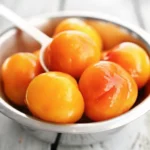Learn how to peel peaches in seconds using the blanching method! This simple technique loosens the skin so it slides right off, making peach prep effortless for cobblers, pies, jams, canning, and freezing.
Peeling peaches doesn’t have to be a tedious, messy chore. With the blanching method, you can transform what would normally be a 30-minute task into a quick 10-minute job. This professional technique is used by chefs and home cooks worldwide to efficiently remove peach skins while preserving the fruit’s integrity.
How to Peel Peaches
Equipment
- Paring Knife
- Cutting board
- Large pot
- Large Bowl or Sink
- Slotted Spoon
Materials
- 10 fresh freestone peaches
- 4 cups boiling water
- 4 cups ice cubes
- 4 cups cold water
Instructions
- Bring water to a roaring boil in a large pot.
- With a small knife, lightly score a small X on the bottom of each peach.
- Place peaches in boiling water for 30–45 seconds using a slotted spoon.
- Immediately transfer peaches to an ice bath for 1 minute.
- Remove and peel using fingers or a paring knife, starting at the X.
- Optional Lemon Soak: Mix 1 tablespoon lemon juice with 2 cups water. Stir peeled peaches in the mixture, then drain to prevent browning if not using immediately.
Notes
Table of Contents
Why Peel Peaches?
While eating fresh peaches with the skin on is perfectly fine and nutritious, there are compelling reasons to peel them for cooking and preserving:
Texture Benefits: Peach skins become fibrous and tough when cooked, creating an unpleasant texture in baked goods, smoothies, and preserves. Removing the skin ensures a smooth, uniform consistency.
Preservation Quality: Peeled peaches freeze more evenly and maintain better texture after thawing. The skin can become slimy and tough during the canning process, affecting the final product’s quality.
Dehydration Results: When drying peaches or making fruit leather, the skins become chewy and unpalatable. Peeling beforehand ensures a better final product.
Safety Considerations: Peach skins may retain more pesticide residue than the flesh, making peeling a wise choice for those concerned about chemical exposure.
Versatility: Peeled peaches blend seamlessly into smoothies, sauces, and baked goods without compromising texture or appearance.
Peeling vs. Blanching: Which Method is Best?
Traditional Peeling Method
Using a peeler or paring knife works well for firm, unripe peaches. However, this method has significant drawbacks:
- Wastes considerable fruit flesh
- Time-consuming for large batches
- Messy with ripe, juicy peaches
- Requires more skill to avoid nicking the fruit
Blanching Method (Recommended)
Blanching involves briefly boiling peaches then plunging them into ice water. This method offers superior results:
- Skin slides off in seconds
- Minimal fruit loss
- Perfect for large batches
- Works best with ripe peaches
- Professional technique used in commercial kitchens
Step-by-Step Blanching Instructions
Equipment Needed
- Large pot for boiling water
- Slotted spoon
- Large bowl or clean sink for ice bath
- Sharp paring knife
- Timer
- Plenty of ice
The Blanching Process
Step 1: Prepare Your Setup Fill a large pot with enough water to fully submerge your peaches. Bring to a rolling boil. While waiting, prepare an ice bath by filling a large bowl or clean sink with ice and cold water.
Step 2: Score the Peaches Using a sharp knife, lightly score a small “X” on the bottom of each peach. The cut should just break the skin – don’t go deep into the flesh.
Step 3: Blanch the Peaches Using a slotted spoon, carefully lower 1-2 peaches into the boiling water (start small until you’re comfortable with the timing). Set a timer for 30-45 seconds. You’ll know they’re ready when you see the skin beginning to curl away from the scored marks.
Step 4: Ice Bath Transfer Immediately transfer the peaches to the ice bath using your slotted spoon. The contrast between hot and cold causes the skin to separate from the flesh.
Step 5: Peel Away the Skin After 1-2 minutes in the ice bath, the peaches will be cool enough to handle. Starting at the scored “X,” gently peel the skin away with your fingers. It should slide off effortlessly.
Pro Tips for Perfect Results
Choose the Right Peaches: Select peaches that yield slightly to gentle pressure. They should be ripe but not overripe or mushy.
Timing is Everything: Set a timer and stick to it. Over-blanching makes peaches mushy, while under-blanching leaves the skin difficult to remove.
Keep Ice Water Cold: When processing large batches, replenish ice frequently. Cold water is crucial for stopping the cooking process.
Work in Batches: Start with 1-2 peaches until you’re comfortable, then increase to 6-8 at a time for efficiency.
Have Everything Ready: Prepare your ice bath before you start blanching. You’ll need to transfer peaches quickly.
Troubleshooting Common Issues
Skin Won’t Come Off: The peach may not be fully ripe or needs more blanching time. Return it to boiling water for another 20-30 seconds.
Peaches Are Mushy: You’ve over-blanched them. Reduce the blanching time for your next batch.
Ice Water Warming Up: Replace ice frequently, especially when processing large quantities.
Beyond Peaches: Other Fruits to Blanch
This technique works wonderfully for other stone fruits and produce:
- Nectarines
- Plums
- Apricots
- Pears
- Tomatoes
Creative Uses for Blanched Peaches
Once you’ve mastered peach blanching, the culinary possibilities are endless:
Preserving: Use for canning, freezing, or making jam and preserves Baking: Perfect for pies, cobblers, muffins, and cakes Beverages: Smoothies, cocktails, and infused waters Desserts: Ice cream, sorbet, and fruit salads Breakfast: Oatmeal toppings, yogurt mix-ins, and pancake fillings
Storage and Preservation
Immediate Use: Freshly blanched peaches should be used within a few hours for best quality.
Refrigeration: Store peeled peaches in the refrigerator for up to 3 days. Wrap whole peaches in plastic wrap and place in resealable bags. Store sliced peaches in airtight containers.
Preventing Browning: Create a lemon bath using 1 tablespoon lemon juice mixed with 2 cups water. Briefly dip peaches in this solution before storing to prevent oxidation.
Freezing: Blanched peaches freeze beautifully and maintain better texture than unblanched fruit.
Removing Peach Pits
After blanching and peeling, removing the pit is straightforward:
- Insert a small knife at the stem end
- Run the blade along the pit, keeping it against the stone
- Twist the two halves in opposite directions
- The pit should be exposed and easy to remove
The Bottom Line
Blanching peaches transforms a tedious kitchen task into a quick, efficient process. With just a few minutes of preparation and the right technique, you can peel 30+ peaches in about 10 minutes. This method preserves the fruit’s integrity while ensuring perfect texture for all your culinary creations.
Whether you’re preparing peaches for immediate use or preserving them for later, mastering this blanching technique will save you time and frustration while delivering professional-quality results every time.

